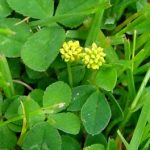Deir an Dúmheidic (Black Medick): “Ba mhaith liomsa a bheith i m’iomaitheoir freisin!” Posted by róislín on Mar 13, 2012 in Irish Language
(le Róislín)
In the last blog (blogs.transparent.com/irish/an-tseamrog-the-shamrock/), I noted that there were at least eight contenders for the title of “shamrock,” including seamsóg (wood-sorrel) and various types of seamair (clover). The blog I cited (www.naturalistsalmanac.com/0317stpat.html) mentioned there being eight possibilities, but only elaborated on six (five types of clover and the wood-sorrel). So what are the other two? Well, I’ve found ceann amháin acu, but am still looking for the eighth one.
So here’s iomaitheoir an lae (the contender of the day): dúmheidic [DOO-VEDJ-ik], black medick (Medicago lupulina), aka Blackweed, Black Nonsuch (aka Black Nonesuch), and Black Hay. Each node of this plant bears three leaves, creating confusion with various clovers (like seamair dhuimhche/Hop Trefoil) and the so-called “false shamrock” (the wood sorrel, which we could perhaps acknowledge as an actual “sham shamrock”).
Black medick is found throughout, most of the world, it seems, so we could probably have an interesting time collecting names for it in different languages. At least I’d enjoy that! Among other locations, it’s found in Europe, most of Asia, North Africa, and the United States. It has bright yellow flowers and its seed pods are black when ripe, hence the name. It is used both as a forage crop and an intercrop, but there are some concerns about it since, to use botanists’ lingo, its “invasive potential” is “medium,” due to its high rate of seed production.
Why is it called “medick,” with a suggestion of medicinal use in the Latin name also (medicago)? I see some references to it having antibacterial properties when made into a water-based extract. It’s described as “soothing,” which sounds fairly open to interpretation to me. It is also described as “lenitive,” a term which certainly warms the cockles of my grammar-delirious heart. Now we just need the Irish for “lenitive,” to distinguish it from our friends “lenite,” “lenition,” and “lenitable.” And yes, we have it … “maolaitheach,” which would have made sense to me from the get-go. “Maolaitheach” comes from “maolú,” which can mean “toning down,” “dulling,” or “lessening,” as well as the more material “dehorning,” as in cows, and “becoming bald”.
Black medick’s cousin, meidic bhreac, has a dark spot in the center of each leaf, hence its name, which literally means “spotted medick.” As for how either spotted or black medick differs from meidic na mbó (purple medick aka lucerne aka alfalfa, lit. cows’ medick) I can’t really say. Dath, is dócha. Luibheolaí, duine ar bith? Or how about it, a bha? Cén mheidic is blasta?
So can medick ever have four leaves, as clover sometimes does? “I’m looking over a four-leaved medick …” – not quite! Maybe I should have quit while I was ahead!
Anyway, that makes an seachtú hiomaitheoir in this assessment. Ar lorg uimhir a hocht fós.
And here’s a grammar quandary for those so inclined. If “contenders” are usually people, counted with the “personal number” system (duine, beirt, triúr, srl.), what happens if plants are the contenders? Uimhreacha pearsanta nó na gnáthbhunuimhreacha ([GNAW-WUN-IV-rukh-uh], with the “g” pronounced, no relation to English “to gnaw”], ordinary cardinal numbers)?
And just in case you were wondering, maidir leis an athfhriotal [AH-RIT-ul] i dteideal an bhlag seo, sin athleagan d’fhrása Marlon Brando (mar Terry) sa scannán On The Waterfront: “I coulda been a contender.” Misneach, a dhúmheidic! Níl sé rómhall duitse fós! At least you haven’t been labeled “false”! SGF, Róislín
Gluais: ar lorg, searching (for); athleagan, paraphrase (n); iomaitheoir, contender; misneach [MISH-nyukh], courage; rómhall [row-wal], too late.
And perhaps a little more circuitously, due to the delights of the Irish genitive-lenitive combo above, dumhach ([DOO-ukh], a dune). And where on earth was that sa téacs thuas. It modifies “seamair,” which is feminine singular, as an attributive noun. For that purpose, “dumhach” is both lenited and put in its gentive case, which is “duimhche” ([DIV-hyuh], of a dune), when lenition doesn’t apply. The word “duimhche” also has a bit of spelling syncopation, but sin ábhar blag eile. And btw, actually, I wouldn’t normally use the medical term “lenitive” in a linguistic context, but here, I just <osna> couldn’t resist.
As for why “Hop Trefoil” is called “Hop” in English and “of a dune” in Irish, tá sé sin taobh amuigh de mo bháillcheantar. Eolas ag duine ar bith agaibh? Can you make beer from it, as you do from leannlusanna? Do coiníní hop over it? Or do dune-bunnies hop over it? Doubt it, but dunno!

Build vocabulary, practice pronunciation, and more with Transparent Language Online. Available anytime, anywhere, on any device.





Leave a comment: